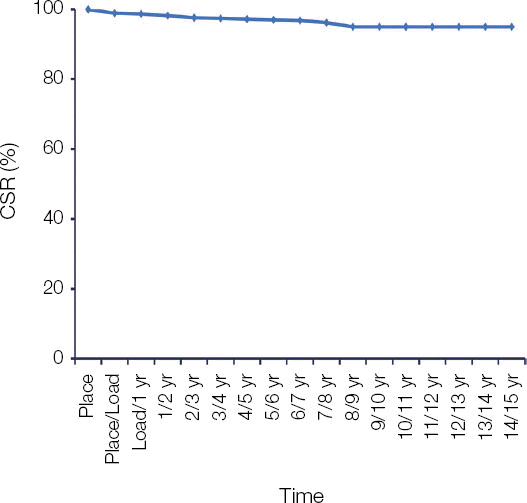1. Berglundh T, Persson L, Klinge B. A systematic review of the incidence of biological and technical complications in implant dentistry reported in prospective longitudinal studies of at least 5 years. J Clin Periodontol. 2002; 29:197–212. DOI:
10.1034/j.1600-051X.29.s3.12.x. PMID:
12787220.
2. Roos-Jansåker AM, Lindahl C, Renvert H, Renvert S. Nine- to fourteen-year follow-up of implant treatment. Part I: Implant loss and associations to various factors. J Clin Periodontol. 2006; 33:283–9. DOI:
10.1111/j.1600-051X.2006.00907.x. PMID:
16553637.
3. Moy PK, Medina D, Shetty V, Aghaloo TL. Dental implant failure rates and associated risk factors. Int J Oral Maxillofac Implants. 2005; 20:569–77. PMID:
16161741.
4. Fugazotto PA. Success and failure rates of osseointegrated implants in function in regenerated bone for 6 to 51 months: a preliminary report. Int J Oral Maxillofac Implants. 1997; 12:17–24.
5. Smith RA, Berger R, Dodson TB. Risk factors associated with dental implants in healthy and medically compromised patients. Int J Oral Maxillofac Implants. 1992; 7:367–72. PMID:
1289263.
7. Strietzel FP, Reichart PA, Kale A, Kulkarni M, Wegner B, Küchler I. Smoking interferes with the prognosis of dental implant treatment: a systematic review and meta-analysis. J Clin Periodontol. 2007; 34:523–44. DOI:
10.1111/j.1600-051X.2007.01083.x. PMID:
17509093.
8. Karoussis IK, Salvi GE, Heitz-Mayfield LJ, Brägger U, Hämmerle CH, Lang NP. Long-term implant prognosis in patients with and without a history of chronic periodontitis: a 10-year prospective cohort study of the ITI dental implant system. Clin Oral Implants Res. 2003; 14:329–39. DOI:
10.1034/j.1600-0501.000.00934.x. PMID:
12755783.
9. Evian CI, Emling R, Rosenberg ES, Waasdorp JA, Halpern W, Shah S, Garcia M. Retrospective analysis of implant survival and the influence of periodontal disease and immediate placement on longterm results. Int J Oral Maxillofac Implants. 2004; 19:393–8. PMID:
15214224.
10. Sbordone L, Barone A, Ciaglia RN, Ramaglia L, Iacono VJ. Longitudinal study of dental implants in a periodontally compromised population. J Periodontol. 1999; 70:1322–9. DOI:
10.1902/jop.1999.70.11.1322. PMID:
10588495.
11. Nevins M. Will implants survive well in patients with a history of inflammatory periodontal disease? J Periodontol. 2001; 72:113–7. DOI:
10.1902/jop.2001.72.1.113. PMID:
11210068.
13. Chuang SK, Wei LJ, Douglass CW, Dodson TB. Risk factors for dental implant failure: a strategy for the analysis of clustered failure-time observations. J Dent Res. 2002; 81:572–7. DOI:
10.1177/154405910208100814. PMID:
12147750.
15. Simonis P, Dufour T, Tenenbaum H. Long-term implant survival and success: a 10-16-year followup of non-submerged dental implants. Clin Oral Implants Res. 2010; 21:772–7. DOI:
10.1111/j.1600-0501.2010.01912.x. PMID:
20636731.
16. Bain CA, Moy PK. The association between the failure of dental implants and cigarette smoking. Int J Oral Maxillofac Implants. 1993; 8:609–15. PMID:
8181822.
17. Huynh-Ba G, Friedberg JR, Vogiatzi D, Ioannidou E. Implant failure predictors in the posterior maxilla: a retrospective study of 273 consecutive implants. J Periodontol. 2008; 79:2256–61. DOI:
10.1902/jop.2008.070602. PMID:
19053914.
18. Zupnik J, Kim SW, Ravens D, Karimbux N, Guze K. Factors associated with dental implant survival: a 4-year retrospective analysis. J Periodontol. 2011; 82:1390–5. DOI:
10.1902/jop.2011.100685. PMID:
21417587.
19. Shiau HJ, Reynolds MA. Sex differences in destructive periodontal disease: a systematic review. J Periodontol. 2010; 81:1379–89. DOI:
10.1902/jop.2010.100044. PMID:
20450376.
21. Ferreira SD, Silva GL, Cortelli JR, Costa JE, Costa FO. Prevalence and risk variables for peri-implant disease in Brazilian subjects. J Clin Periodontol. 2006; 33:929–35. DOI:
10.1111/j.1600-051X.2006.01001.x. PMID:
17092244.
22. Anitua E, Orive G, Aguirre JJ, Ardanza B, Andía I. 5-year clinical experience with BTI dental implants: risk factors for implant failure. J Clin Periodontol. 2008; 35:724–32. DOI:
10.1111/j.1600-051X.2008.01248.x. PMID:
18616758.
23. Scurria MS, Morgan ZV 4th, Guckes AD, Li S, Koch G. Prognostic variables associated with implant failure: a retrospective effectiveness study. Int J Oral Maxillofac Implants. 1998; 13:400–6. PMID:
9638011.
24. Alsaadi G, Quirynen M, Michiles K, Teughels W, Komárek A, van Steenberghe D. Impact of local and systemic factors on the incidence of failures up to abutment connection with modified surface oral implants. J Clin Periodontol. 2008; 35:51–7. PMID:
18034851.
25. Rodrigo D, Aracil L, Martin C, Sanz M. Diagnosis of implant stability and its impact on implant survival: a prospective case series study. Clin Oral Implants Res. 2010; 21:255–61. DOI:
10.1111/j.1600-0501.2009.01820.x. PMID:
19958375.
26. Quirynen M, Abarca M, Van Assche N, Nevins M, van Steenberghe D. Impact of supportive periodontal therapy and implant surface roughness on implant outcome in patients with a history of periodontitis. J Clin Periodontol. 2007; 34:805–15. DOI:
10.1111/j.1600-051X.2007.01106.x. PMID:
17716316.
27. Ong CT, Ivanovski S, Needleman IG, Retzepi M, Moles DR, Tonetti MS, Donos N. Systematic review of implant outcomes in treated periodontitis subjects. J Clin Periodontol. 2008; 35:438–62. DOI:
10.1111/j.1600-051X.2008.01207.x. PMID:
18433385.




 PDF
PDF Citation
Citation Print
Print



 XML Download
XML Download